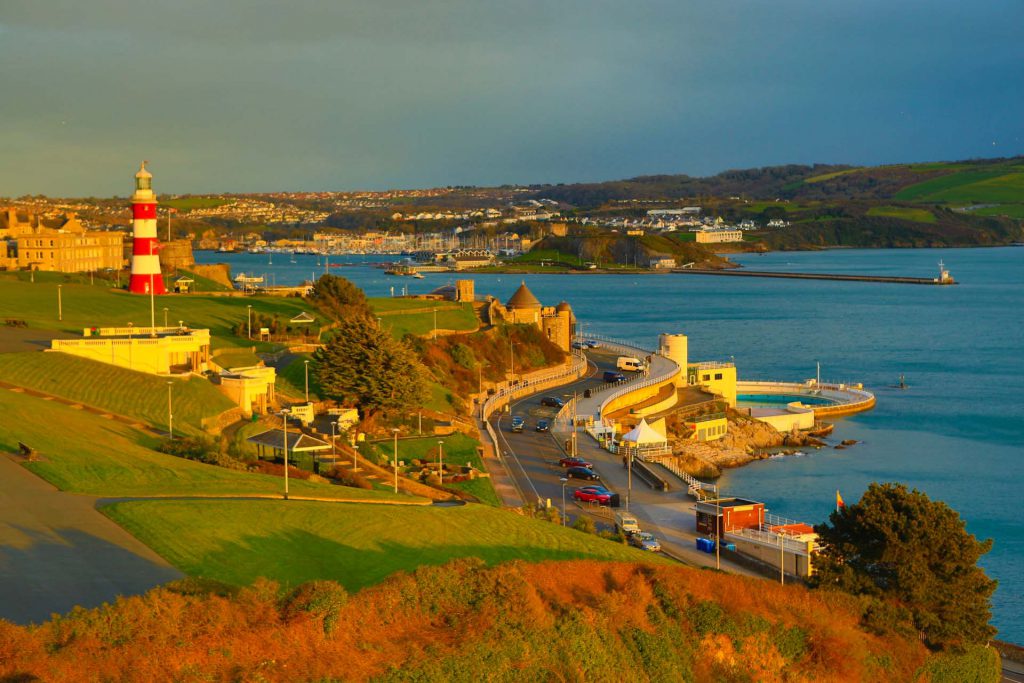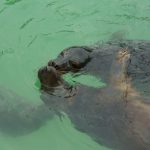A country swaying to the rhythm of the oceans
England represents half of the surface area of Great Britain and one-third of its coasts. It has been a sea-oriented country since the prehistoric times : most of its inhabitants live within 60 Km of the coast and none of them lives farther than 115 Km from the coast. The sea has influenced the history, culture, gastronomy, politics and recreational infrastructure of the country. While the advent of the industrial era led the people to move away from coastal areas, the granting of employee leaves and the development of modern means of communication have facilitated the return of populations to the coast. The tradition of working-class holidays was established towards the late 19th century, mainly in seaside resorts. The extension of the railway network at about the same time led to the development of seaside towns in England, with the movement of population from urban centres. The significant number of large cities along major waterways or close to estuaries also explains the strong bond that connects the British people with the sea.
The climate of England is tempered by the presence of the ocean and of the Gulf Stream
The best months to visit the country are from May through September. The temperature is mild with significant drops in winter between December and March. January and February are harsh especially in the northern part and in the mountainous part of Scotland, where it can snow for several weeks. The climate however remains wet, including during the summer period. Average temperature varies between 2°C and 7°C in winter and between 11°C and 21°C in summer. The eastern part of the country has a little drier climate with larger differences in temperature.
Consideration for the marine environment
Residents and visitors to the British coasts are satisfied to note the significant number of structures designed in order to preserve the landscapes and marine biodiversity as well as address environmental challenges of the 21st century. The UK is a signatory of various international agreements such as the Bern Convention de Bern, the 1992 Rio Convention on Biodiversity and the OSPAR Convention for the protection of the marine environment of the North-East Atlantic, which was signed in Paris and entered into force in 1998. In addition, the country has implemented EU Directives by setting up a network of Marine Protected Areas to achieve the objectives set by the European Community in Directive 2008/56/EC, which defines the « Good Environment Status » of marine waters by 2020.
Various Marine Protected Areas adapted to the species and habitats
In order to implement Article 3 relating to the protection of habitats 189 animal species, including 43 species native to the British Isles, highly protected sites have been set up. To allow the application of EU recommendations contained in Article 4 relating to birds, Specially Protected Areas (SPAs) have been set up. Marine Conservation Areas declared of national significance have also been created. Their role is to protect the marine wildlife, habitats and the geology of the coastline as is the case off the coasts of England and Wales. The Scottish authorities retain the prerogative of designating Marine Protected Areas within their national space. These various measures allow a number of organisations, associations and businesses to offer excellent conditions for the discovery of the coasts, marine life and reserves by the local population and tourists, with increasing demand for closer interaction with the wild natural world.
The choice of alternative marine energy resources
The UK is unquestionably the leading world centre for research on the development of technologies to harness wave and tidal current energy. Various complementary marine sites are now equipped, allowing a number of countries including Germany, France, Japan and China to carry out tests in British waters.
England seems to draw from its maritime past part of the resources required to take up the new challenge of more sustainable development of the oceans. The south-west of the country especially is on the front line with the key universities of Exeter and Plymouth, as well as the laboratories of the Marine Biological Association (MBA) or the Plymouth Marine Laboratory (PML) which help increase scientific knowledge of the marine environment. The coast of Cornwall is the base for the wave energy transformation project. This Wave Hub holds 8 Km2 of ocean surface on a 25-year lease. It has a landfall for cable connection with the open sea area where four connections are used to test various equipments. On January 2013 the Irish company Ocean Energy has signed an agreement with the Wave Hub centre for testing its platform which has already demonstrated its ability to survive to the waves in this stormy part of the Atlantic Ocean.
The Crown Estate has for many years now been reputed as a key promoter in the implementation of the British policy for sustainable development of natural resources.
It is to be noted that the ownership of the seabed up to a distance of 12 miles from the coast and the possibility to exploit certain natural resources up to a distance of 200 miles put the Crown Estate in a favourable position to exploit the resources. Investment in offshore wind energy or the exploitation of wave energy and tidal currents remains however remains particularly relevant and timely.
Among the various activities related to the exploitation of the coastline and the sea by the Crown Estate, the production of renewable energy is the one that achieved the greatest progress with revenue of £7.8 million over the financial year to March 2012 against £3.5 million in the previous year. The total revenue derived from the exploitation of the coastline and the sea amounts to £55.6 million. To date, 4.2GW of electricity is produced by wind power while another 4.9GW is scheduled or is under development. In the short run, the UK will have 36 offshore wind farms, which is larger than any other country in the world.
In parallel, powerful structures have been set up to achieve the objectives set by the state. For example, PRIMaRE (Peninsula Research Institute for Marine Renewable Industry) combines the competencies of the Universities of Plymouth and Exeter and is supported by the government through the Department for Business Innovation and Skills (BIS). The development reliable of modelling tools taking into account all the energy contained in waves and omni-directional currents as well as variable power is an ambitious goal, from which the coast of Cornwall will be the first to benefit.
A consortium like the European Technology Institute is investing in technologies of the future. A sum of £25 million has been earmarked for 2012 to achieve by 2020 the production of 18GW from floating offshore wind turbines. This technology would allow the exploitation of sites where the wind has the best technical characteristics. According to the European Offshore Renewable Energy roadmap, this would represent a share of the 460GW projected at European level in the medium term.
Another example is SuperGenUK. Around the three founding universities of Edinburgh, Dublin Queen’s University and Exeter, it combines seven other universities to tackle the challenge of renewable energy production by 2020 by integrating a maximum set of skills from the fields of research and industry, including international competencies.
Among the various businesses, Current Turbines, based in Bristol, stands a world leader in the exploitation of tidal currents to produce clean energy. The company was taken over by Siemens and has developed a real expertise through tests conducted in different parts of the UK. The system is similar to that of underwater windmills except that given the fact that the density of water is a lot higher than that of air, the surface and length of blades are significantly reduced. A device allows the vertical movement of the mechanism to optimise the positioning of the blades with regard to the current and tidal level. It also allows on-the-spot maintenance at the surface, thus avoiding the transportation of the mechanisms and building ships that are specifically adapted to this type of maintenance. The electric current produced by the turbine is transported over a short distance to be fed directly into the grid. This technology is protected by various international patents. The Marine Current Turbines have a real potential for energy generation. They have been tested on site since 2008 and have already produced more than 3GW.
Nautical events in keeping with the country’s maritime history
Various regattas are held on the stretch of water during the year with a staggering number of regattas in June and July, thus confirming the maritime tradition of the country.
Cowes Dayboat Regattas
The Cowes Week was created in 1826 and takes place towards mid-August. It remains the best nautical event in the UK. During an entire week, thousands of boats race each other every day in some 41 legs.
Isle of Wight Around the Island Tour
In June, the Isle of Wight Around the Island Tour allows almost 2,000 boats to compete with each other. Thousands of seamen from around the world race each other on the stretch of water, which offers an amazing spectacle for those watching from the coast.
Super Yacht Cup
In July, there is the Super Yacht Cup in which take part some 20 sailboats measuring over 24 m long. The Panerai British Classic Week brings together classical old boats during a week for the pleasure of the eyes. The Hundred Guinea Cup, with Class-J boats racing each other a short distance from the shore of the Isle of Wight, which allows thousands of spectators to enjoy the show. The Brewin Dolphin Commodore’s Cup allows amateur crews from many countries to compete with each other.
The Weymouth Speed Week
The competition is held in October every year on the stretch of water between Portland and Weymouth, which is sheltered from sea waves. The race is open to any type of board or hull pulled along by a kitewing. In such conditions, anyone can try to beat the world record of 55.65 knots held by the American, Robert Douglas.
Several other professional races such as solo and crewed round the world races that have been held on a regular basis since decades.
A unique maritime history
England plays a leading role in the maritime history of the UK. As early as the Bronze Age, boats capable of navigating the oceans are known to have been in service with the discovery in 1992 at Dover of a boat of an estimated length of 11 m whose oak and yew hull was stitched. The boat appears to date from 1550 BCC, which makes it the oldest marine boat to date. It is on display at the Dover Museum.
Alfred the Great and the early days of the British naval fleet
It is also recognised, through archaeological findings, trade was already flourishing since the Iron Age between the different parts of the UK and Gaul. A means of transport was the Curragh, a sailboat whose hull consisted of a wooden frame and animal skins.
Later in 793 AD, the Vikings began to make incursions in England with the plunder of Lindisfame Monastery on the northeastern coast of Northumberland. Most of the English territory was then under occupation, except for the Wessex, where the younger brother of the King, Alfred, aged 23, distinguished himself by defeating the Danish at the Battle of Ashdown. It is considered that the history of England in relation to that of the UK began with King Alfred, who managed to bring together the Anglo-Saxons and stand up to the enemy. He was the only King of England to be dubbed « The Great ». It is generally accepted that it was under his reign that an early naval fleet consisting of boats with forms similar to those of the Vikings – and with 60 oars to go up rivers and compensate for the absence of wind – was created. In 875 Alfred claimed victory in a naval battle.
The popularity of boats whose hull planking was assembled by clincher
Historians note the lasting influence of the naval architecture of the peoples of Northern Europe on the UK. The hull planking of their shallow draft boats with elegant lines were assembled by clincher. They were thus light and robust and particularly adapted to the needs of marine transport of the time. While boats used for warfare were long and narrow for maximum speed, those devoted to trade were broader in order to load large quantities of goods. Clincher works were well adapted to average size wooden boats and was used for centuries. It is to be noted that this construction method was used in the in the Middle Aged to build commercial vessels called clogs.
The great age of British exploration
England distinguished itself during the great age of exploration between the 15th and the 18th century. The distant lands discovered were mapped and commercial routes were established. The privateer, Sir Francis Drake became the first British navigator to sail around the world, discovering on the way the mythical Cape Horn. In 1620, the legendary ship, Mayflower left Plymouth and crossed the Atlantic to reach the New World. The settlement of migrants in very harsh conditions became the symbol of the establishment of the first colonist in America.
In the 18th century, James Cook, one of the most famous navigators of all times, led his first expedition in the Pacific between 1766 and 1771. After having rounded Cape Horn, he crossed the Pacific and mapped the coasts of New Zealand and eastern Australia. On his way back, he rounded the Cape of Good Hope. On his second voyage between 1772 and 1775, he was the first navigator to cross the Antarctic Circle. He went back to Tahiti and mapped, amongst others, the Marquesas Islands and Easter Island. He returned in 1776 for a third expedition during which he was unfortunately killed in Hawaii.
The supremacy of the Royal Navy
In parallel with these discoveries, the Royal Navy developed and helped to secure commercial routes. The setting up of military ports in the south of the country, the creation of shipyards for shipbuilding and repair also contributed to ensure the supremacy of the Navy over the seas. The setting up of a true battle fleet is attributed to King Henry VIII. Olivier Cromwell boosted the fleet size from 35 to 154 between 1648 and 1660. In the 1700s, the size of the fleet was increased through government borrowing.
England asserted its supremacy during several naval battles, especially during Napoleonic Wars, when it defied the French and Spanish fleets. It thus continued to control a large part of maritime routes and world trade. The fleet remained the largest and most efficient one until World War I, when the USA, Germany and Japan challenged its naval superiority.





